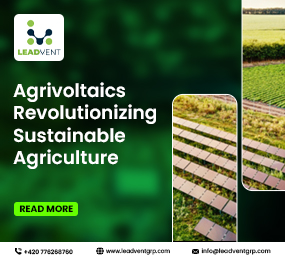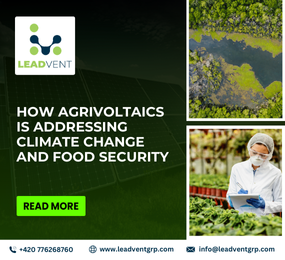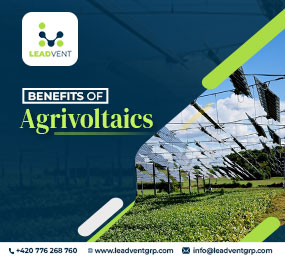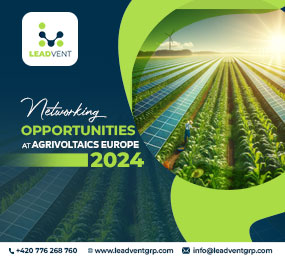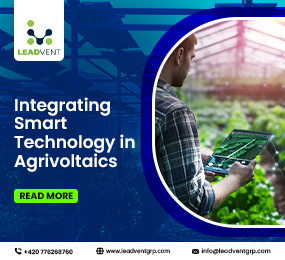As the world grapples with the dual challenges of food security and renewable energy, AgriVoltaics— the integration of solar power generation with agriculture—has emerged as a promising solution. This innovative approach optimizes land use by enabling the simultaneous production of crops and electricity, offering a pathway toward sustainability. However, the implementation of AgriVoltaics is not without its challenges, ranging from regulatory hurdles to technological complexities.
The 3rd Annual AgriVoltaics Summit organized by Leadvent Group presents an invaluable opportunity for stakeholders to explore these challenges and discover innovative solutions driving the future of AgriVoltaics.
Understanding AgriVoltaics and Its Benefits
AgriVoltaics integrates photovoltaic (PV) panels with agricultural activities, striking a balance between energy generation and farming productivity. This approach offers multiple advantages:
- Enhanced Land Use Efficiency: Utilizing the same land for farming and solar energy boosts sustainability.
- Climate Resilience: PV panels provide partial shading, reducing soil moisture loss and protecting crops from extreme weather.
- Economic Benefits: Farmers gain additional income through energy production, while communities benefit from cleaner energy sources.
- Carbon Footprint Reduction: By promoting renewable energy, AgriVoltaics supports global carbon neutrality goals.
Despite these advantages, widespread adoption faces several barriers that must be addressed to unlock its full potential.
Key Challenges in AgriVoltaics
1. Policy and Regulatory Barriers
One of the primary obstacles is the lack of clear policies and regulations governing AgriVoltaics. Many countries still categorize agricultural and energy land use separately, leading to restrictions on dual-use farming.
Solutions:
- Governments need to establish specific AgriVoltaics regulations and incentives.
- Policymakers should streamline permitting processes to encourage adoption.
- Financial incentives such as tax benefits and subsidies can make AgriVoltaic investments more attractive.
2. Technological Integration and Efficiency
Balancing energy generation with agricultural productivity remains a technical challenge. PV panels can create shading effects that impact crop yield, while also requiring effective system designs to maximize energy output.
Solutions:
- Development of adjustable or semi-transparent solar panels to optimize light distribution.
- Smart tracking systems that adapt panel positioning based on sunlight and crop needs.
- Advanced agronomic studies to determine the best crops for AgriVoltaic farming.
3. Economic Viability and Investment Risks
High initial capital costs deter many farmers and investors from embracing AgriVoltaics. Additionally, uncertainties about long-term profitability create hesitancy.
Solutions:
- Establishing public-private partnerships to share financial risks.
- Research-backed financial models demonstrating long-term returns.
- Community-driven investment programs to lower capital entry barriers.
4. Grid Integration and Energy Storage
Intermittency in solar power generation presents a challenge for grid stability. Without effective energy storage and smart grid integration, the efficiency of AgriVoltaics can be limited.
Solutions:
- Investing in battery storage systems to manage surplus energy.
- Smart grid solutions that enhance energy distribution efficiency.
- Hybrid renewable energy models integrating wind and solar for consistent output.
Driving the Future of AgriVoltaics
Despite these challenges, AgriVoltaics holds immense promise in reshaping the agricultural and energy landscapes. By fostering collaboration between governments, researchers, farmers, and the private sector, the industry can overcome barriers and pave the way for large-scale implementation.
Join the Discussion at the 3rd Annual AgriVoltaics Summit
The 3rd Annual AgriVoltaics Summit will bring together industry experts, policymakers, and innovators to tackle these challenges and explore groundbreaking advancements. Key topics include:
- Policy frameworks for AgriVoltaics expansion.
- Next-generation solar technologies for agricultural integration.
- Investment strategies to boost AgriVoltaics adoption.
- Case studies on successful AgriVoltaic projects worldwide.
For those at the intersection of agriculture and renewable energy, this summit is a must-attend event to stay ahead of emerging trends and opportunities.
Register today and be part of the AgriVoltaics revolution!
For full event details, visit the4th Annual AgriVoltaics Europe
Interested in speaking?
If you want to participate in the conference as a speaker, please kindly contact Mark Perry at [email protected]
Don’t miss this opportunity to improve your knowledge and showcase your products directly to your target audience & leaders from innovative and forward-thinking companies in the solar energy sector.
Plan on sending a team. For maximal benefit, we highly recommend that you send a team of 3+ to attend the event. That’s why we offer group booking discounts—enquire now to find out more—available for a LIMITED TIME ONLY.
Are you ready to be a part of the event?
Save 50% if you book by 28th March.
Limited sponsorship opportunities are available; contact me today at Martin Smith, [email protected] | +420 776 268 760.
For more information on delegate registration and group participation, contact us at [email protected].
Leadvent Group—Industry-Leading Events for Business Leaders!



